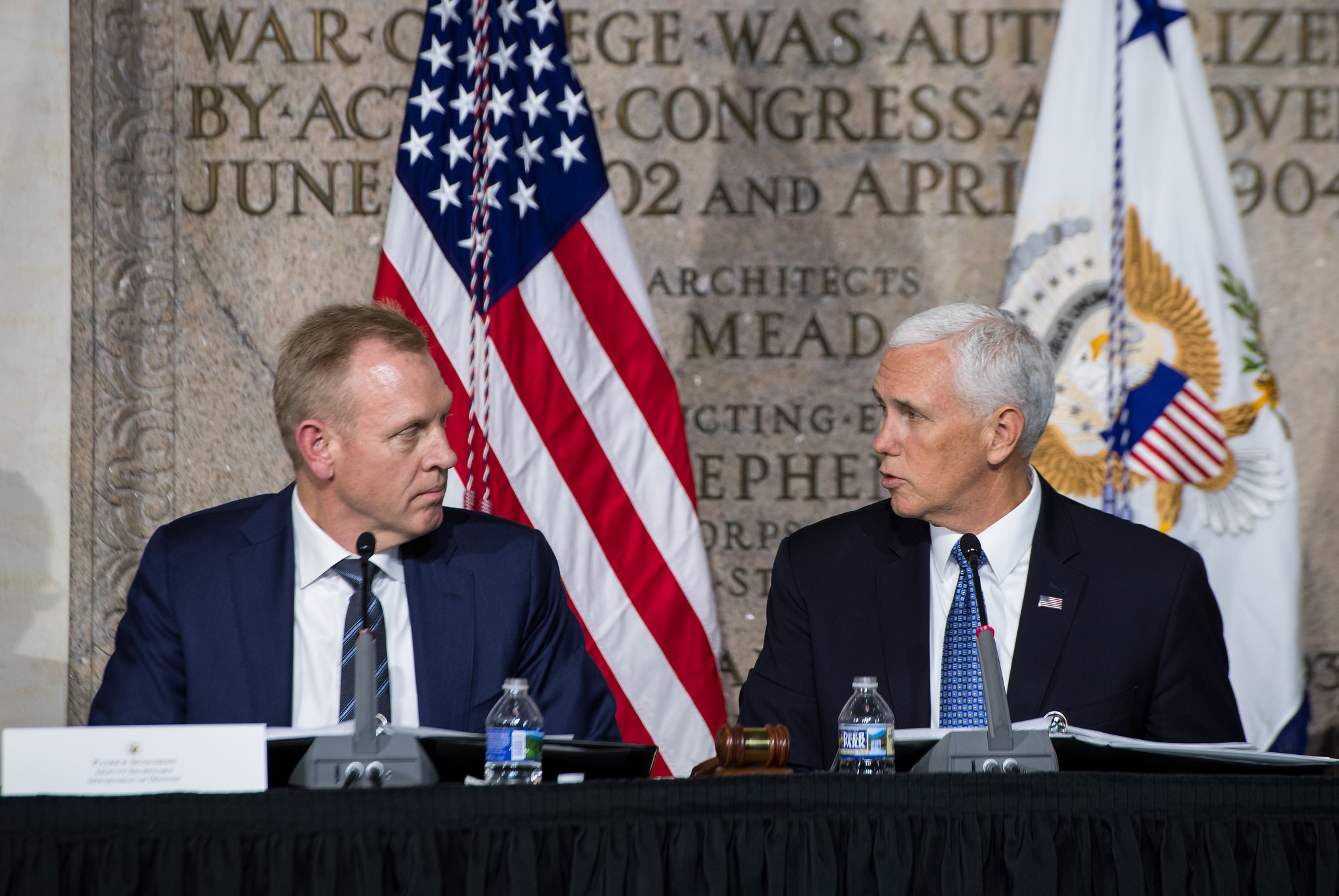The Arms Industry Is Taking Over Trump’s Pentagon
Rather than curbing the blatant conflicts inherent in the revolving door he previously criticized, the president is accelerating them. Acting Secretary of Defense Patrick Shanahan, left, spent 30 years at Boeing. (NASA HQ PHOTO / CC BY-NC-ND 2.0)
Acting Secretary of Defense Patrick Shanahan, left, spent 30 years at Boeing. (NASA HQ PHOTO / CC BY-NC-ND 2.0)
The way personnel spin through Washington’s infamous revolving door between the Pentagon and the arms industry is nothing new. That door, however, is moving ever faster with the appointment of Patrick Shanahan, who spent 30 years at Boeing, the Pentagon’s second largest contractor, as the Trump administration’s acting secretary of defense.
Shanahan had previously been deputy secretary of defense, a typical position in recent years for someone with a significant arms industry background. William Lynn, President Obama’s first deputy secretary of defense, had been a Raytheon lobbyist. Ashton Carter, his successor, was a consultant for the same company. One of President George W. Bush’s deputies, Gordon England, had been president of the General Dynamics Fort Worth Aircraft Company (later sold to Lockheed Martin).
But Shanahan is unique. No secretary of defense in recent memory has had such a long career in the arms industry and so little experience in government or the military. For most of that career, in fact, his main focus was winning defense contracts for Boeing, not crafting effective defense policies. While the Pentagon should be focused on protecting the country, the arms industry operates in the pursuit of profit, even when that means selling weapons systems to countries working against American national security interests.
The closest analogues to Shanahan were Charlie Wilson, head of General Motors, whom President Dwight Eisenhower appointed to lead the Department of Defense (DoD) more than 60 years ago, and John F. Kennedy’s first defense secretary, Robert McNamara, who ran the Ford Motor Company before joining the administration. Eisenhower’s choice of Wilson, whose firm manufactured military vehicles, raised concerns at the time about conflicts of interest — but not in Wilson’s mind. He famously claimed that “for years I thought what was good for the country was good for General Motors and vice versa.”
Shanahan’s new role raises questions about whether what is in the best interest of Boeing — bigger defense budgets and giant contracts for unaffordable and ineffective weaponry or aircraft — is what’s in the best interest of the public.
Rampant Conflicts of Interest
Unlike Wilson, Shanahan has at least implicitly acknowledged the potential for conflicts of interest in his new role by agreeing to recuse himself from decisions involving his former employer. But were he truly to adhere to such a position, he would have to avoid many of the Pentagon’s most significant management and financial decisions. Last year, after all, Boeing received nearly $30 billion in DoD contracts for working on everything from combat, refueling, training, and radar planes to bombs, drones, missile-defense systems, ballistic missiles, and military satellites. If Shanahan were to step back from deliberations related to all of these, he would, at best, be a part-time steward of the Pentagon, unable even to oversee whether Boeing and related companies delivered what our military asked for.
There is already evidence, however, that he will do anything but refrain from overseeing, and so promoting, his old firm. Take Boeing’s F-15X, for example. Against the wishes of the Air Force, the Pentagon decided to invest at least $1.2 billion in that fighter aircraft, an upgraded version of the Boeing F-15C/D, which had been supplanted by Lockheed Martin’s questionable new F-35. There have been reports that Shanahan has already trashed Lockheed, Boeing’s top competitor, in discussions inside the Pentagon. According to Bloomberg News, the decision to invest in the F-15X was due, in part at least, to “prodding” from him, when he was still deputy secretary of defense.
And that’s just one of a slew of major contracts scooped up by Boeing in the past year. Others include a $9.2 billion program for a new training aircraft for the Air Force, an $805 million contract for an aerial refueling drone for the Navy, two new presidential Air Force One planes at a price tag of at least $3.9 billion, and significant new funding for the KC-46 refueling tanker, a troubled plane the Air Force has cleared for full production despite major defects still to be addressed. While there is as yet no evidence that Shanahan himself sought to tip the scales in Boeing’s favor on any of these systems, it doesn’t look good. As defense secretary, he’s bound to be called on to referee major problems that will arise with one or more of these programs, at which point the question of bias towards Boeing will come directly into play.
Defenders of Shanahan’s appointment to run what is by far the largest department in the federal government suggest that key Boeing decisions won’t even reach his desk. That, however, is a deeply flawed argument for a number of reasons. To start, when making such decisions, lower-level managers will be aware of their boss’s lifetime connection to Boeing — especially since Shanahan has reportedly sung the praises of his former firm at the Pentagon. He has insisted, for example, that the massive F-35 program would have had none of the serious problems now plaguing it had it been run by Boeing.
In addition, Shanahan will be developing policies and programs sure to directly affect that company’s bottom line. Among them, he’ll be setting the DoD’s priorities when it comes to addressing perceived threats. His initial message on his first day as acting secretary, for instance, was summarized as “China, China, China.” Will he then prime the pump for expensive weapon systems like Boeing’s P-8 Poseidon surveillance aircraft, designed specifically to monitor Chinese military activities?
He has similarly been the Pentagon’s staunchest advocate when it comes to the development of a new Space Force, something that likely thrills President Trump. He’s advocated, for example, giving the Space Development Agency, the body that will be charged with developing military space assets, authority “on steroids” to shove ever more contracts out the door. As a producer of military satellites, Boeing is a major potential beneficiary of just such a development.
 Then there’s missile defense, another new presidential favorite. Shanahan presided over Boeing’s missile defense division at a time when one of the systems being developed was the Airborne Laser, meant to zap launched nuclear missiles with lasers installed on Boeing 747 aircraft. The project, a dismal failure, was cancelled after more than $5 billion in taxpayer funds had been sunk into it. The Pentagon’s latest “Star Wars”-style anti-missile technology, whose developmentwas just announced by President Trump, calls for a major investment in an equally impractical set of technologies at a price that Joseph Cirincione of the Ploughshares Fund suggests could reach $1 trillion in the decades to come.
Then there’s missile defense, another new presidential favorite. Shanahan presided over Boeing’s missile defense division at a time when one of the systems being developed was the Airborne Laser, meant to zap launched nuclear missiles with lasers installed on Boeing 747 aircraft. The project, a dismal failure, was cancelled after more than $5 billion in taxpayer funds had been sunk into it. The Pentagon’s latest “Star Wars”-style anti-missile technology, whose developmentwas just announced by President Trump, calls for a major investment in an equally impractical set of technologies at a price that Joseph Cirincione of the Ploughshares Fund suggests could reach $1 trillion in the decades to come.
Among Boeing’s current missile-defense programs is the Ground-Based Midcourse Defense System, an array of land-based interceptor missiles that has already failed the majority of its tests. It’s unlikely that it will ever function effectively in a situation in which incoming warheads would be accompanied by large numbers of decoys. The Congressional Budget Office has identified the cancellation of the program as one obvious decision that could save significant sums. But what chance is there that Shanahan would support such a decision, given all those years in which he advocated for that missile-defense system at Boeing?
Or take nuclear policy. His former company is one of two finalists to build a new intercontinental ballistic missile (ICBM). Critics of such weapons systems like Clinton administration Secretary of Defense William Perry point out that ICBMs are the most dangerous and unnecessary leg of the U.S. nuclear triad, since in a potential war they might need to be launched on only minutes’ notice, lest they be lost to incoming enemy nukes. Even some of their supporters have questioned the need for a brand-new ICBM when older ones could be upgraded. Nuclear hawks might eventually be persuaded to adopt such a position, too, since the cost of the Pentagon’s across-the-board $1.5 trillion “modernization” of the U.S. nuclear arsenal (including the production of new nuclear bombers, missiles, and warheads) will otherwise begin to impinge on department priorities elsewhere. But how likely is Shanahan to seriously entertain even such modest critiques when they threaten to eliminate a huge potential payday for Boeing?
Finally, there is the issue of U.S. support for the brutal war launched by Saudi Arabia and the United Arab Emirates (UAE) in Yemen nearly four years ago. Boeing’s combat planes, bombs, and attack helicopters have played a central role in that conflict, which has killed tens of thousands of civilians, while a Saudi blockade of the country has put millions more at risk of famine. In addition, Boeing continues to benefit from a $480 million contract to service the F-15s it has supplied to the Royal Saudi Air Force.
Here, President Trump is firmly in that company’s corner. “Boeing, Lockheed, Raytheon… I don’t wanna hurt jobs,” he told 60 Minutes. “I don’t wanna lose an order like that [from the Saudi government].” Before his resignation, Secretary of Defense James Mattis was regularly called upon to comment on the Saudi war and help craft U.S. policy towards both that country and the UAE. Where will Shanahan stand on a war significantly fueled by the products of his former company?
There is, in fact, a grim precedent for Shanahan’s present situation. The Intercept and the Wall Street Journal have both reported that State Department Acting Assistant Secretary for Legislative AffairsCharles Faulkner, a former lobbyist for Raytheon, advocated giving Saudi Arabia a clean bill of health on its efforts to avoid hitting civilians in its air strikes in Yemen, lest Raytheon lose a lucrative bomb deal. So much for draining the swamp.
The Revolving Door Spins Both Ways
Shanahan and Faulkner are far from the only former defense executives or lobbyists to populate the Trump administration. Secretary of the Air Force Heather Wilson is a former lobbyist for Lockheed Martin. Ellen Lord, who heads procurement at the Pentagon, worked at Textron, a producer of bombs and military helicopters. Secretary of the Army Mark Esper — rumored as a possible replacement for Shanahan as secretary of defense — was once a top lobbyist at Raytheon. Undersecretary of Defense for Policy John Rood was a senior vice president at Lockheed Martin. And the latest addition to the club is Charles Kupperman, who has been tapped as deputy national security advisor. His career includes stints at both Boeing and Lockheed Martin. (His claim to fame: asserting that the United States could win a nuclear war.)
All of the above, including Patrick Shanahan, spun through that famed revolving door into government posts, but so many former DoD officials and top-level military officers have long spun in the opposite direction. In 1969, for example, Wisconsin Democratic Senator William Proxmire, a legendary Pentagon watchdog, was already describing the problem this way:
“The easy movement of high-ranking military officers into jobs with major defense contractors and the reverse movement of top executives in major defense contractors into high Pentagon jobs is solid evidence of the military-industrial complex in operation. It is a real threat to the public interest because it increases the chances of abuse… How hard a bargain will officers involved in procurement planning or specifications drive when they are one or two years from retirement and have the example to look at of over 2,000 fellow officers doing well on the outside after retirement?”
Or, as a 1983 internal Air Force memo, put it, “If a colonel or a general stands up and makes a fuss about high cost and poor quality, no nice man will come to see him when he retires.”
As a presidential candidate, Donald Trump appeared to recognize the obvious problem of the revolving door and proposed a five-point ethics reform plan to slow it down, if not shut it down entirely. Unfortunately, the ethics executive order he put in place once in office fell wildly short of his campaign ambitions, leaving that revolving door spinning madly. A new report from the Project On Government Oversight has documented 645 cases in 2018 alone in which former government officials held jobs at the top 20 Pentagon contractors. The leader among them? You probably won’t be surprised to learn that it’s Boeing, with 84 such hires.
Retired Vice Admiral Jeffrey Wieringa, who led the Pentagon’s arms sales office, is a case in point. In that role, he helped promote sales of U.S. weaponry globally. Perhaps as a result, he “earned” himself a position as president for global services and support at Boeing less than a year after he retired. He’s far from alone. Retired Rear Admiral Donald Gaddis, a program officer for Navy air systems, also joined the company, as did retired Air Force Major General Jack Catton Jr., who served as the director of requirements for the Air Combat Command before moving to Boeing. Retired Vice Admiral Mark Harnitchek, the former head of the Defense Logistics Agency, charged with managing $35 billion in goods and services across the DoD annually, similarly became a vice president at Boeing.
Slowing the Revolving Door
Candidate Donald Trump saw the revolving door between government and industry as a problem. “I think anybody that gives out these big contracts should never ever, during their lifetime, be allowed to work for a defense company, for a company that makes that product,” he said. As the continuing flow of officials through it suggests, however, as president, he’s done anything but drain that swamp.
In order to do so, he would, as a start, have to focus his administration on closing the many loopholes in current federal ethics laws, which, however imperfectly, seek to limit conflicts of interest on the part of government officials who move to jobs in industry. Under current law, lobbying restrictions on such former officials can be circumvented if they label themselves “consultants” or “business development executives.” Similarly, former Pentagon officials can go to work for an arms maker they once awarded a contract to as long as they’re hired by a different division of that company. In addition, while Congress requires that the Pentagon track whoever’s moving through that revolving door, the database that does so is both incomplete and not available for public viewing.
Candidate Trump was onto something. However, rather than curbing the blatant conflicts inherent in the revolving door — the ultimate symbol of the military-industrial complex in action — President Trump is actually accelerating them. America is indeed great again, if you happen to be one of those lucky enough to be moving back and forth between plum jobs in the Pentagon and the weapons industry.
Your support is crucial…With an uncertain future and a new administration casting doubt on press freedoms, the danger is clear: The truth is at risk.
Now is the time to give. Your tax-deductible support allows us to dig deeper, delivering fearless investigative reporting and analysis that exposes what’s really happening — without compromise.
Stand with our courageous journalists. Donate today to protect a free press, uphold democracy and unearth untold stories.









You need to be a supporter to comment.
There are currently no responses to this article.
Be the first to respond.